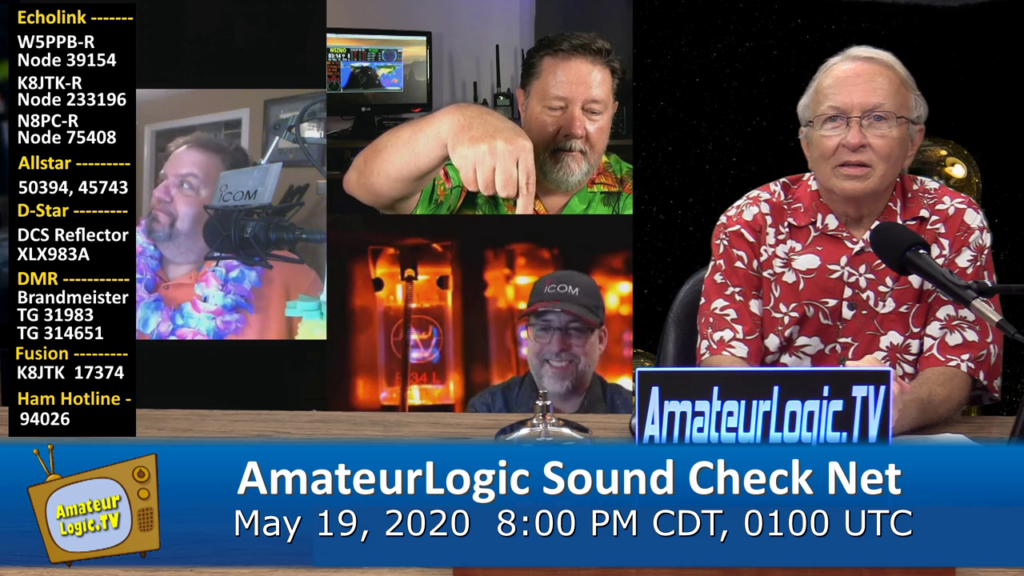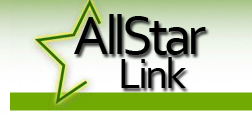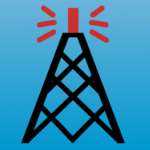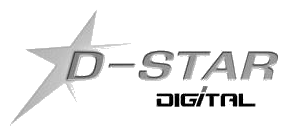
The Hub (also been referred to as a multimode repeater) is a Ham Radio Digital Voice over IP Multimode Interlinked System (DVMIS). It was created in the spirit of ham radio experimentation by supporting Open Sourced projects and interlinking ham radio VoIP modes for interoperability: AllStar Link, EchoLink, DMR, D-STAR, M17, NXDN, P25, and Yaesu System Fusion.
This can be used for an EmComm exercise or a rag-chew meetup where users are utilizing different Ham Radio Internet linking technologies. While convenient in some situations to use non-RF connections, please use RF connections whenever possible to utilize the spectrum we’re given.
The system is mostly stable. I do add/change/update/upgrade things from time to time when the system is not being used. Always susceptible to network/infrastructure conditions. Backup/redundancy plans will be implemented when the system sees general use or is part of critical infrastructure.
Rules
- Follow all rules of your regulatory authority
- Keep it classy
- English only
- Identify your station by voice. Digital stations are used to quick-keying to break-in or check-in, this will not work. IDs in data streams are lost due to analog and cross-linked connections. Users on non-radio VoIP solutions tend to forget they’re on a radio system. Proper ID is required and accepted method is by voice.
- Press PTT and pause for 2 seconds before speaking. This gives time for all links to become operational otherwise, the first couple words of the transmission will be lost.
- Pause a minimum 3-5 seconds between transmissions. Stations cannot break-in when stations quickly key-up (or “tailgate”) after the previous. System timeouts are caused when links are not given proper time to reset.
System usage rules
- Absolutely NO cross-linking with non-Amateur Radio systems (eg: Zello, TeamSpeak, GMRS)
- Common sense and common courtesy. If you don’t know what they are or where to find them, find somewhere else.
- Analog nodes, in particular, need to eliminate all courtesy tones, hang times, squelch tails, IDs, etc. sent over Internet links. This slows things down, could cause a ping-ponging effect, and generally annoying. Set the repeater to use TX PL and link radio to use RX PL COS to transmit audio only when the repeater is active.
Main dashboard and streaming audio
- Supermon dashboard – all connections are through AllStar. This dashboard will show where a call is originating. Additionally, shows AllStar and VoIP telecom (HoIP, AW) connections.
- Brandmeister Hoseline – streaming audio is available through the Brandmeister DMR connection
Accessing the Hub
My callsign will be seen using digital modes. This is because a callsign is needed for the digital modes but one cannot be provided inter-mode, therefore K8JTK is used.
AllStar Link
- 50394
- Node Info
AmateurWire
- 90004
- Greeting: D-V-M-I-S CONNECTED
- *99 to transmit (PTT)
- Remember to unmute!
- # to stop transmitting (release PTT)
DMR – HBLink
- Master HB_US_K8JTK-HUB-DVMIS_DMO
- Talkgroup 31983 (group call), time slot 2
- HBLink monitor dashboard
DMR – Brandmeister
- Brandmeister Talkgroup 3172783 (group call)
- TG 3172783 Hoseline (streaming audio)
- BM TG 3172783 Last heard
- Repeater Dashboard
DMR – TGIF
- TGIF Talkgroup 31983 (group call)
- Dashboard
D-STAR
- XLX983A
- Dashboard
- Only the “A” module is used for the Hub
- In the event of connection problems (unable to connect, frequent disconnects) use:
- DCS983A (Pi-STAR)
- XLX983A (OpenSpot)
- Any of these D-STAR protocols are available if supported by the gateway:
- REF983A (DPlus)
- DCS983A (DCS)
- XLX983A (DCS)
- XRF983A (DExtra)
- G3 Terminal enabled
- XLX crossmode support is not available
EchoLink
- *DVMIS* conference 600008
Hams Over IP
- 15010
- Greeting: D-V-M-I-S CONNECTED
- *99 to transmit (PTT)
- Remember to unmute!
- # to stop transmitting (release PTT)
- BLF Dashboard under “RF-Link Calls”
M17
- M17-983A
- Dashboard
- Only the “A” module is used for the Hub
NXDN
- TG 31983
- Dashboard
- DMR2NXDN via DMRGateway: TG 7031983
- Available on NXCore
P25
- TG 31983
- Dashboard
YSF
- K8JTK-Hub 31983
- Mode: DN or narrow. Transmissions in VW or wide mode will pass on the reflector, but will not pass to the Hub.
- Dashboard
- YSF DTMF & DMR2YSF: 31983
- DMR2YSF via DMRGateway: TG 7031983
- Do NOT use Wires-X search functions while connected
Wires-X
- K8JTK-ROOM 40680
- There is a 3-second delay from Wires to the rest of the hub. Transmissions occurring during the delay will preclude the Wires transmission from making it to the hub.
IAX2 Clients
Use of IAX clients is discouraged because they do not use ham spectrum. E-mail me with your call and verifiable email address (listed on QRZ, for example).
No longer available
- Brandmeister discontinued the use of TG 31983
- Hamshack Hotline has terminated the DVMIS extension due to an incompatibility with native AllStar Link and their system. Instead of working with the ASL project on a solution for their SMS issue, they terminated extensions running native AllStar Link.
Skeds (scheduled contacts)
The term “gateway” is all encompassing to describe a device that can establish a connection via network to the system. A gateway could be any or all of a repeater node, simplex node, hotspot, or application. In the same way, “node” describes talkgroups, extensions, nodes, links, reflectors, rooms, and conferences.
W1AW on AllStar wants to chat with K8JTK on D-STAR. Each station must connect their gateway the appropriate node as listed above. W1AW must connect an AllStar Link capable node to 50394 and K8JTK must connect a D-STAR capable node to XLX983A. More information on gateway options is available below.
W1AW cannot instruct or direct the system to establish a connection to another node where K8JTK is already connected or vice-versa. All connections MUST be incoming into DVMIS system. There are no outgoing connections from the system except for approved nets.
Nets
Nets are listed in Eastern Time and UTC.
This utility will convert between Time Zones since different parts of the world change DST/STD on different days. Use “Eastern Time, ET” as the starting Time Zone for conversion.
Monday
8 PM ET (0000 UTC DST/0100 UTC Std on Tue) – West Chester Amateur Radio Association WC8VOA. This net includes a broadcast of the Amateur Radio Newsline. Breaks during the Newsline broadcast will happen approximately every 3 minutes.
Tuesday
9 PM ET/6 PM PT (0100 UTC DST/0200 UTC Std on Wed) – AmateurLogic Sound Check Net. The Amateur Logic Sound Check Net ended 12/27/2022.
Fourth Tuesday of the month at 9 PM ET/6 PM PT (0100 UTC DST/0200 UTC Std on Wed) – Taking the place of the Sound Check Net in 2023 is the Amateur Logic “Logic Net.”
I get to host these goofballs…

Christmas Eve
6 PM EST (2300 UTC) 12/24 – Santa Watch Net on *DoDropIn*
Amateur Logic.TV Segment
A segment aired on episode 149 about this hub. You can find the presentation here and video below.
VoIP Systems
Notes and information for accessing the Hub using available systems.
Bridging these systems, networks, and protocols allows voice traffic to pass between them. An Echolink station can talk with an D-STAR station for example.
Though many have made the argument ‘all of this is digital,’ distinction is modulation type. Analog systems are ones that are typically associated with analog modulations: AllStar Link, EchoLink, Hams Over IP, AmateurWire, IAX. Digital DMR, D-STAR, NXDN, P25, YSF.
Analog
 AllStar Link: a ham radio linking system based on Asterisk. This analog system can be used on anything from repeaters to portable nodes. Implementations: AllStar Link and HamVoIP. See my write-up on AllStar. Accessible via any AllStar Link node using an analog ham radio.
AllStar Link: a ham radio linking system based on Asterisk. This analog system can be used on anything from repeaters to portable nodes. Implementations: AllStar Link and HamVoIP. See my write-up on AllStar. Accessible via any AllStar Link node using an analog ham radio.
AllStar is built on Asterisk. Asterisk serves up IAX connections. This serves as last resort (ie: EchoLink client, hotspot, other apps) for those who are RF limited. Clients known to work: iaxrpt, DVSwtich (non-Google), Zopier, RepeaterPhone (iOS).
 EchoLink: widely utilized Internet linking program. Windows desktop application for users or nodes is dated and not actively maintained but still seems to work on later versions. Linux users install QTel through the package manager. Smartphone applications for Android and iOS. Nodes or repeaters can be built using the Windows app, SVX Link, or chan_echolink on AllStar/HamVoIP. Accessible via any of the apps or any EchoLink node using an analog ham radio. RepeaterPhone (iOS) connects to EchoLink nodes.
EchoLink: widely utilized Internet linking program. Windows desktop application for users or nodes is dated and not actively maintained but still seems to work on later versions. Linux users install QTel through the package manager. Smartphone applications for Android and iOS. Nodes or repeaters can be built using the Windows app, SVX Link, or chan_echolink on AllStar/HamVoIP. Accessible via any of the apps or any EchoLink node using an analog ham radio. RepeaterPhone (iOS) connects to EchoLink nodes.
Hams Over IP and AmateurWire: are IP telecom systems for amateur radio. Both support any SIP phones, adapters, or softphone applications as they are a bring your own device (BYOD) solution.
Digital
Digital requires a radio to generate modulation and a gateway device for connecting to digital networks. Networks listed are available on gateways (repeaters or personal hotspots) through MultiMode Digital Voice Modem (MMDVM), Wires-X is the exception. MMDVM is available on devices such as OpenSpot or hardware supported by Pi-Star.
Many hotspots can translate digital RF of one modulation to a network of a different type. Examples of translated radio to network:
- DMR <-> YSF (Fusion)
- DMR <-> NXDN
- Fusion <-> DMR
- Fusion <-> NXDN
- Fusion <-> P25
OpenSpot3 is currently the only device that can transcode D-STAR to other network types (except P25).
HBLink (DMR): repeaters or hotspots capable of using the HomeBrew repeater protocol through MMDVM (Pi-STAR) or DMRplus (OpenSpot). This option is an alternative to Brandmeister and TGIF, which have issues from time-to-time.
 Brandmeister (DMR): repeaters or hotspots linked to Brandmeister – direct or MMDVM.
Brandmeister (DMR): repeaters or hotspots linked to Brandmeister – direct or MMDVM.
TGIF (DMR): repeaters or hotspots linked to TGIF via MMDVM.
DMR capable radios are available from TYT, Bridgecom, Alinco, or any DMR Tier-2 capable commercial radio.
 D-STAR: repeaters or hotspots with access to DCS/XLX reflectors or MMDVM capability. D-STAR capable radios are available from ICOM or Kenwood.
D-STAR: repeaters or hotspots with access to DCS/XLX reflectors or MMDVM capability. D-STAR capable radios are available from ICOM or Kenwood.
M17: M17 capable devices are limited at this time, visit the project site for updates.
NXDN/NXDNReflector: see digital modes above. NXDN capable radios are available through ICOM and Kenwood – commercial radio divisions.
P25/P25Reflector: see digital modes above. P25 capable radios are available through Motorola, Tait, Kenwood, ICOM, Harris, EFJohnson… to name a few – commercial radio divisions.
![]() YSF/YSFReflector: see digital modes above. C4FM/Fusion capable radios are only available through Yaesu.
YSF/YSFReflector: see digital modes above. C4FM/Fusion capable radios are only available through Yaesu.
Note about Yaesu Wires-X: Wires-X is a proprietary format to Yaesu System Fusion radios and repeaters. Only way to add Wires-X support is through an RF link – which is available at times or can be made available by request.
Behind the Scenes
AllStar has the concept of private nodes which cannot be linked to publicly. They are used to manage links and systems such as individual repeaters, nodes, links, etc – they can be anything defined by the sysop. They are four-digit numbers beginning with a 1, ie 1XXX. My defined numbering scheme on The Hub:
100X = rooms or channels (1000-1003)
1000 = main room where DVMIS nodes connect by default
1001-1003 = available for linking two or more nodes/modes upon request.
12XX = analog connections
1202 = Echolink
1203 =
1204 = Hams Over IP
1205 = AmateurWire
1206 = IAX clients (DVSwitch, Zopier, iaxrpt, etc.)
50394 = Allstar Link (publicly accessible)
13XX = digital connections
1311 = HBLink DMR
1312 = Brandmeister DMR
1313 = TGIF DMR
1321 = D-STAR XLX reflector
1331 = NXDNReflector
1341 = P25Reflector
1351 = YSFReflector
1361 = M17Reflector